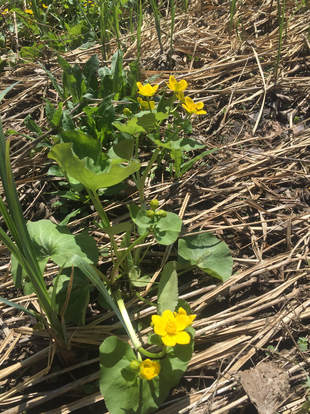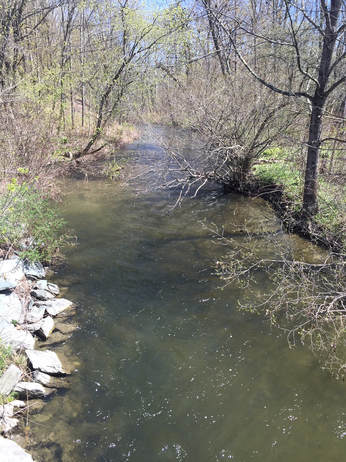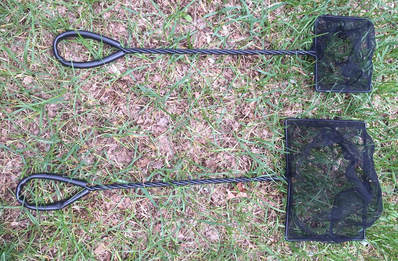 Marsh Marigolds Marsh Marigolds I know I speak for all our readers when I say, "Finally! Yay!!" It seems like we've been waiting for these warm sunny days for many weeks. Yesterday, when my wife Nancy and I were in Burlington, it was gorgeous if a bit breezy. Today, back in Castleton, it's an equally beautiful day and meant to hit 70 degrees. While some of our streams and rivers are high-to-very-high and Lake Champlain is at flood stage, in a couple of days water levels will drop, and the woods are bursting with life, including wonderful wildflowers. Get out there--if you can with your students--to enjoy this wonderful time of year! But now is also the time to plan or finish up planning your Release Day. As far as I'm aware, our first Release Day will be next Tuesday, May 15, when Seth Bonnett and Melissa Rice and their Manchester Elementary-Middle School students travel to Smokey House in Danby, Vermont, to spend several hours studying Mill Brook, their release stream, and saying goodbye to their diligently reared fish. Especially if this is your first Release Day, you might benefit from watching a few RD videos. Here's one of my favorites (except for the segment with the guy in the orange hat). You should know that this wasn't Steve Flint's first Release Day, and he chose to plan an ambitious three hours of activities, in part because he was able to recruit a large number of volunteers to help with the five stations he set up. Don't feel that your Release Day needs to be like Steve's. Each RD should match the culture of the school, the amount of time you want to devote to it, how comfortable you are getting students involved in fieldwork, the number of volunteers you can get to help, etc. The Release Day Videos page on the VTTIC Web site contains links to eight other RD videos. These will give you different ideas on how to approach your Release Day. Here's a link to that page. When and where will your RD take place? Publicity for TIC. When I can, I like to let both Trout Unlimited members and staff of Vermont's Fish and Wildlife Department know where and when our Release Days will be held. The more people we can get to observe and experience these wonderful educational experiences, the more individuals we'll be able to recruit for volunteer roles in the future. I will also relay details on RDs to members of the media in the hope that at least a few might choose to show up and document our activities. That kind of publicity is great for the program and could lead other schools to apply to participate next year. With regard to publicity, local TIC teachers and volunteers are undoubtedly in the best position to get press coverage. When I send a blind e-mail to a newspaper, especially a regional one, where I don't have personal contacts, that e-mail is likely to result in "Crickets!" When you contact that paper, however, you'll probably receive much better attention. And the smallest newspapers in Vermont, which often don't have paid reporters, much less full-time reporters, are typically very happy to print your press release, especially when it's accompanied by photos of kids having a great time in a stream. So let me know the where and when of your Release Day. Count those fry! In the past, some schools have neglected to count their fish before releasing them. If you don't count them, you will probably never know how many you released. Why is that? Some teachers use what I call the "subtraction method." They make an assumption about how many eggs they started with and then subtract the eggs and fish they know they lost. But this approach, for reasons identified below, is never accurate. Indeed, some teachers I've worked with have discovered that their actual total number of fish is two or more dozen more that they thought they had. Sometimes it's fewer. Here are some explanations.
So, what's the best way to count them? I know at least one teacher who builds counting the fry into the Release Day process. He sets up a recording station staffed by a couple of students. Then each team that has been given fry and released them goes to the recording station to report the number they released. Most teachers, however, count fry as they remove them from the tank and transfer them to whatever container (more on containers later) they are going to use to transport the fry to the stream. Here's what I recommend.
Tree planting! When, three years ago, Sebastian Saunders was a 5th grader at the Dorset School, TIC teacher Karli Love and her students participated in the TIC program.This past Saturday, Sebbie, now an 8th grader at Dorset, led an impressive project that resulted in 40 volunteers planting 280 trees along the banks of the Batten Kill in Manchester. Sebbie had proposed this to our local Trout Unlimited chapter as his Eagle Scout project. This tree planting became extremely desirable after the elimination of the dam that had created Dufresne Pond. The dam was removed to open up several miles of headwater spawning grounds, but the bottom of the pond, once it was again a stream, provided almost barren habitat for fish and other aquatic species. There was virtually no structure behind and beneath which fish could hide and no protective cover. Instead, the Batten Kill's water cooked in the sun. Here are some pictures from the wonderful tree planting effort. Congratulations, Sebastian, and thanks! Charlotte Central School 6th graders talk to astronauts! Imagine my surprise last Wednesday night when, while watching the WCAX late news, I saw Tasha Grey being interviewed! And it had nothing to do with TIC. It turns out that CCS 6th graders of Tasha's and Christa Duthie-Fox, got to converse with two astronauts aboard the International Space Station. I snapped this photo of our TV screen during that interview. Here's a quote on the project that appeared in the school newsletter:
Our CCS students were amazing - the quality of the questions that they asked was quite impressive and allowed for an excellent dialogue with the NASA astronauts. The work of the students leading up to Wednesday’s downlink included using Earthkam photos in their studies of geography, and have recently completed an ISS design challenge inspired by Apollo 13 which had them design an emergency insulation system to keep a battery warm in the extreme temperatures of space using only basic materials that can be found onboard the station. Students are currently working on research projects exploring some of the actual science experiments the astronauts are conducting and supporting on the ISS, looking at topics including material science, radiation impacts on DNA, experimental space habitats, and microgravity plant growth. Congratulations, Tasha and Christie. What a great learning opportunity for your students!
0 Comments
Leave a Reply. |
Joe Mark is Lead Facilitator of Vermont's Trout in the Classroom program.In June 2012, I retired after 40 years in higher education, having spent the last 32 years of my career as dean at Castleton. One of the first things I volunteered to do in retirement was to work with a parent-friend to help the Dorset School, where his kids and my Vermont grandkids attend, start a TIC program. Gradually that commitment grew into my current role, which is both demanding and highly rewarding. Archives
December 2019
Categories |





 RSS Feed
RSS Feed
